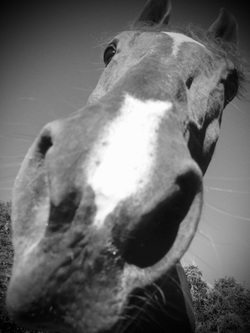FREQUENTLY ASKED QUESTIONS & CONCERNS

What is the difference between what you do and what my natural hoof trimmer does?
The differences are many. The primary objective in AEP (Applied Equine Podiatry) is to secure and respect what is called the Internal Arch Apparatus, IAA. The Internal Arch includes soft tissue, lateral cartilages and all connective and sensitive structures within. The IAA is what we balance to, using the application of the HPT (High Performance Trim) Method, stimulating the correct structures. Stimulus being the primary factor in our method is what holds us apart from the natural trimmers. We also do not subscribe to the wild horse for an adequate foot or hoof in which to use as a model for trimming. The law of physics basic mathematical formula of (F = M x A) Force equals Mass times Acceleration, is enough to throw out the wild hoof model without scientific study. Wild horses do not have rider weight, tack, repetitive domestic motion, level of speed, or environmental influences that our domestic horses have. Applied Equine Podiatry is the cutting edge alternative to the farrier sciences. What we are striving for is tough as nails hooves that will surpass most disciplines where the foot is concerned.
The differences are many. The primary objective in AEP (Applied Equine Podiatry) is to secure and respect what is called the Internal Arch Apparatus, IAA. The Internal Arch includes soft tissue, lateral cartilages and all connective and sensitive structures within. The IAA is what we balance to, using the application of the HPT (High Performance Trim) Method, stimulating the correct structures. Stimulus being the primary factor in our method is what holds us apart from the natural trimmers. We also do not subscribe to the wild horse for an adequate foot or hoof in which to use as a model for trimming. The law of physics basic mathematical formula of (F = M x A) Force equals Mass times Acceleration, is enough to throw out the wild hoof model without scientific study. Wild horses do not have rider weight, tack, repetitive domestic motion, level of speed, or environmental influences that our domestic horses have. Applied Equine Podiatry is the cutting edge alternative to the farrier sciences. What we are striving for is tough as nails hooves that will surpass most disciplines where the foot is concerned.
I would try barefoot, but my horse needs the traction of a shoe in order to race.
Every horse is unique and what is needed for the individual horse will vary. There are many successful shoeless horses performing all kinds of disciplines which include racing. A metal shoe when under force or when wet is quite slippery therefore requiring the need for studs. The best traction a horse can have is a properly functioning hoof which is perfect by design. A healthy hoof has a natural crease on the edge called the junction of the sole to the golden line. You will find this same crease on your horses' shoe. This ridge is designed to trap dirt along with the collateral grooves between the frog and bars, dirt on dirt creates great traction.
My horse can't go shoeless; he goes lame.
How have you gone about transitioning to shoeless in the past? What are your expectations with your horse? Are you willing to give him the TIME he needs to get a healthy foot under him?
When making the decision to transition your horse to shoeless you should first learn about proper foot function and be ready and committed to take the journey with your horse. It's not a matter of pulling shoes applying a trim and hoping for the best, that would be cruel. You will better your horse's success at transitioning to shoeless by working with a DAEP (Diploma in Applied Equine Podiatry). This person has had extensive education along with continued education on the horses foot and how to return proper function.
When making the decision to transition your horse to shoeless you should first learn about proper foot function and be ready and committed to take the journey with your horse. It's not a matter of pulling shoes applying a trim and hoping for the best, that would be cruel. You will better your horse's success at transitioning to shoeless by working with a DAEP (Diploma in Applied Equine Podiatry). This person has had extensive education along with continued education on the horses foot and how to return proper function.
How long does the transition from shoes to shoeless take; when will I be able to ride?
The answer varies per horse. Every horse is unique and it is true that some horses may never succeed shoeless; age, breed, discipline, rider weight, environment, and owner commitment are all factors. It's understanding that the horse has the innate ability to heal itself, provided the environment is conducive to healing. It takes time and commitment from the owner to give the horse a successful chance at going shoeless. TIME being very important, if you cannot commit to this, then it is in the best interest of your horse to remain in shoes.
*All content provided on this website is for informational purposes only, and is not intended to substitute veterinary advice.
This website is copy right of Mindful Equus, Integrity in Hoof Care, and Emily Judd, DAEP. All Rights Reserved 2020 © Permission granted for use of information from The Institute of Applied Equine Podiatry founder KC LaPierre, RJF, MEP, MIAEP.
This website is copy right of Mindful Equus, Integrity in Hoof Care, and Emily Judd, DAEP. All Rights Reserved 2020 © Permission granted for use of information from The Institute of Applied Equine Podiatry founder KC LaPierre, RJF, MEP, MIAEP.